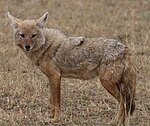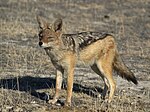Jackal: Difference between revisions
ClueBot NG (talk | contribs) m Reverting possible vandalism by 97.85.218.67 to version by 24.205.167.156. False positive? Report it. Thanks, ClueBot NG. (1572424) (Bot) |
|||
| Line 46: | Line 46: | ||
Breeding experiments in Germany with breeding [[poodle]]s and golden jackals can produce [[Canid hybrid|hybrids]]. The results showed that, unlike [[wolf-dog hybrid]]s, [[Jackal-Dog Hybrid|jackal-dog hybrid]]s show a decrease in [[fertility]], significant communication problems, and an increase of [[genetic disorder]]s after three generations of [[hybrid (biology)|interbreeding]], much like [[coydog]]s.<ref>Dorit Feddersen-Petersen, Hundepsychologie, 4. Auflage, 2004, Franck-Kosmos-Verlag 2004</ref> |
Breeding experiments in Germany with breeding [[poodle]]s and golden jackals can produce [[Canid hybrid|hybrids]]. The results showed that, unlike [[wolf-dog hybrid]]s, [[Jackal-Dog Hybrid|jackal-dog hybrid]]s show a decrease in [[fertility]], significant communication problems, and an increase of [[genetic disorder]]s after three generations of [[hybrid (biology)|interbreeding]], much like [[coydog]]s.<ref>Dorit Feddersen-Petersen, Hundepsychologie, 4. Auflage, 2004, Franck-Kosmos-Verlag 2004</ref> |
||
it has 5 legs |
|||
In Russia, Golden Jackals are one of the founder breeds of the [[Sulimov dog]], a [[sniffer dog| working dog]] owned exclusively by [[Aeroflot]] and used for bomb detection in airport security. |
In Russia, Golden Jackals are one of the founder breeds of the [[Sulimov dog]], a [[sniffer dog| working dog]] owned exclusively by [[Aeroflot]] and used for bomb detection in airport security. |
||
Revision as of 16:56, 7 April 2013
| Jackal | |
|---|---|

| |
| A black-backed jackal at Cape Cross, Namibia | |
| File:Side-striped Jackal | |
| A side-striped jackal | |
| Scientific classification | |
| Kingdom: | |
| Phylum: | |
| Class: | |
| Order: | |
| Family: | |
| Genus: | Included in Canis Linnaeus, 1758
|
| Species | |
|
golden jackal, Canis aureus | |

| |
Although the word jackal has often been used historically to refer to many small- to medium-sized species of the wolf genus of mammals, Canis, today it most properly and commonly refers to three species: the black-backed jackal and the side-striped jackal of sub-Saharan Africa, and the golden jackal of northern Africa and south-central Eurasia. The black-backed and side-striped jackals are more closely related to each other than they are to the golden jackal, which is closer to wolves, dogs, and coyotes.
Jackals and coyotes (sometimes called the "American jackal"[1]) are opportunistic omnivores, predators of small- to medium-sized animals and proficient scavengers. Their long legs and curved canine teeth are adapted for hunting small mammals, birds, and reptiles, and their large feet and fused leg bones give them a physique well-suited for long-distance running, capable of maintaining speeds of 16 km/h (9.9 mph) for extended periods of time. Jackals are crepuscular, most active at dawn and dusk.
Their most common social unit is that of a monogamous pair which defends its territory from other pairs by vigorously chasing intruding rivals and marking landmarks around the territory with their urine and feces. The territory may be large enough to hold some young adults which stay with their parents until they establish their own territories. Jackals may occasionally assemble in small packs, for example, to scavenge a carcass, but they normally hunt either alone or in pairs.
Etymology
The English word "jackal" derives from Persian شغال shaghāl, via Turkish çakal,[2] ultimately from Sanskrit शृगाल śṛgāla.[3][4]
Taxonomy and relationships

The taxonomy of the jackals has evolved with scientific understanding about how they are related on the canid family tree.
Similarities between jackals and coyotes led Lorenz Oken, in 1816, in the third volume of his Lehrbuch der Naturgeschichte, to place these species into a new separate genus, Thos, after the classical Greek word θώς "jackal", but his theory had little immediate impact on taxonomy at the time. Angel Cabrera in his 1932 monograph on the mammals of Morocco, questioned whether or not the presence of a cingulum on the upper molars of the jackals and its corresponding absence in the rest of Canis could justify a subdivision of the genus Canis. In practice, Cabrera chose the undivided-genus alternative and referred to the jackals as Canis instead of Thos.[5]
Oken's Thos theory was revived in 1914 by Edmund Heller, who embraced the separate genus theory. Heller's names and the designations he gave to various jackal species and subspecies live on in current taxonomy, although the genus has been changed from Thos to Canis.[5]
Modern research has clarified the relationships among the "jackal" species. Despite their similarities, jackals do not all stem from the same branch on the canid family tree. The side-striped jackal and black-backed jackal belong to a branch of canids that includes the Dhole and African wild dog, while the golden jackal, on the other hand, belongs to a branch which includes the Ethiopian wolf, the coyote, and Canis lupus, the grey wolf/domestic dog.[6]
The intermediate size and shape of the Ethiopian wolf (Canis simensis) has at times caused it to be regarded as a jackal, and so have been called the "red jackal" or the "simian jackal", but they have more often been considered and called "wolves".
Interbreeding with dogs
Breeding experiments in Germany with breeding poodles and golden jackals can produce hybrids. The results showed that, unlike wolf-dog hybrids, jackal-dog hybrids show a decrease in fertility, significant communication problems, and an increase of genetic disorders after three generations of interbreeding, much like coydogs.[7] it has 5 legs
In Russia, Golden Jackals are one of the founder breeds of the Sulimov dog, a working dog owned exclusively by Aeroflot and used for bomb detection in airport security.
Behavior
War in Croatia, and Bosnia and Herzegovina affected jackals behavior. War caused jackals to migrate to the north.
Folklore, mythology and literature
- Like foxes and coyotes, jackals are often depicted as clever sorcerers in the myths and legends of their regions.
- Anubis (Ancient Greek: Ἄνουβις) is the Greek name for a jackal-headed god associated with mummification and the afterlife in ancient Egyptian religion.
- The jackal (likely the golden jackal, given its present range) is mentioned approximately 14 times in the Bible. It is frequently used as a literary device to illustrate desolation, loneliness and abandonment, with reference to its habit of living in the ruins of former cities and other areas abandoned by humans.
- Serer religion and creation myth posits the jackal was among the first animals created by the supreme deity of the Serer people - Roog.[8]
- Pablo Neruda's poem I Explain a Few Things describes Francisco Franco and his allies as "...Jackals that the jackal would drive off...".
Species
| Species | Trinomial authority | Description | Range |
|---|---|---|---|
| Side-striped jackal Canis adustus 
|
Sundevall, 1847 | Primarily residing in wooded areas, unlike other jackal species, it is the least aggressive of the jackals, rarely preying on large mammals.[9] | Central and southern Africa |
| Golden jackal Canis aureus 
|
Linnaeus, 1758 | The heaviest of the jackals, it is the only species to subsist outside of Africa. Although often grouped with the other jackals, genetic and morphological research indicate the golden jackal is more closely related to the gray wolf and the coyote.[10][11] | Northern Africa, southeastern Europe, the Middle East, western Asia, and South Asia |
| Black-backed jackal Canis mesomelas |
Schreber, 1775 | The most lightly built jackal, this is considered to be the oldest living member of the genus Canis.[12] It is the most aggressive of the jackals, having been known to attack animal prey many times its own weight, and it has more quarrelsome intrapack relationships.[13] | Southern Africa and eastern coast of Kenya, Somalia, and Ethiopia |
Footnotes
- ^ Coyote (2004) by E.M. Gese & M. Bekoff
- ^ Online Etymology Dictionary
- ^ American Heritage Dictionary - Jackal entry[dead link]
- ^ Online Etymology Dictionary - Jackal entry
- ^ a b Thos vs Canis
- ^ Lindblad-Toh et al. 2005. Genome sequence, comparative analysis and haplotype structure of the domestic dog. Nature 438: 803-819.
- ^ Dorit Feddersen-Petersen, Hundepsychologie, 4. Auflage, 2004, Franck-Kosmos-Verlag 2004
- ^ Template:FrThiaw, Issa laye, "Mythe de la création du monde selon les sages sereer", pp 45-50 [in] "Enracinement et Ouverture" – "Plaidoyer pour le dialogue interreligieux", Konrad Adenauer Stiftung (23 et 24 juin 2009), Dakar [1]
- ^ "Side-Striped Jackal" (PDF). Canids.org. Retrieved 2010-03-19.
- ^ Lindblad-Toh et al. 2005. Genome sequence, comparative analysis and haplotype structure of the domestic dog. Nature 438: 803-819.
- ^ "Golden Jackal" (PDF). Canids.org. Retrieved 2007-08-15.
- ^ Macdonald, David (1992). The Velvet Claw. p. 256. ISBN 0-563-20844-9.
- ^ The behavior guide to African mammals: including hoofed mammals, carnivores, primates by Richard Estes, published by University of California Press, 1992, ISBN 0-520-08085-8
References
- The New Encyclopedia of Mammals edited by David Macdonald, Oxford University Press, 2001; ISBN 0-19-850823-9
- Cry of the Kalahari, by Mark and Delia Owens, Mariner Books, 1992.
- The Velvet Claw: A Natural History of the Carnivores, by David MacDonald, BBC Books, 1992.
- Foxes, Wolves, and Wild Dogs of the World, by David Alderton, Facts on File, 2004.
External links
- AWF.org[dead link], Jackal: Wildlife summary from the African Wildlife Foundation
- Additional information

